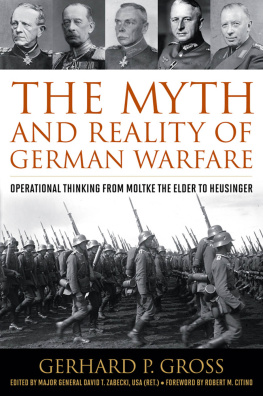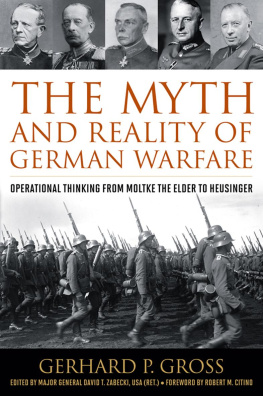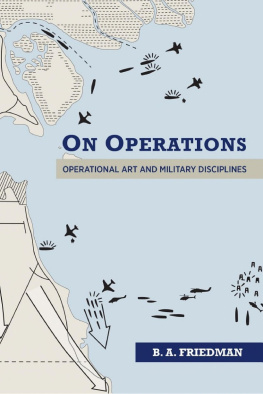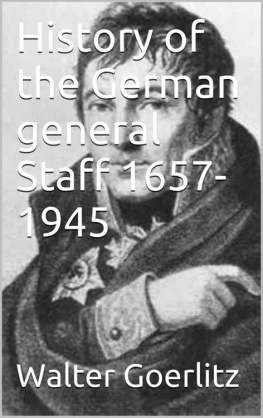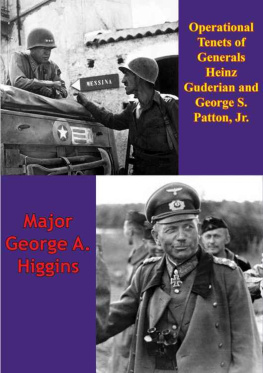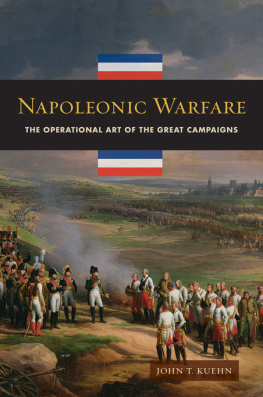The Myth and Reality of German Warfare
FOREIGN MILITARY STUDIES
History is replete with examples of notable military campaigns and exceptional military leaders and theorists. Military professionals and students of the art and science of war cannot afford to ignore these sources of knowledge or limit their studies to the history of the U.S. armed forces. This series features original works, translations, and reprints of classics outside the American canon that promote a deeper understanding of international military theory and practice.
SERIES EDITOR: Roger Cirillo

An AUSA Book
THE MYTH
AND REALITY OF
GERMAN WARFARE
Operational Thinking from Moltke the Elder to Heusinger
COLONEL GERHARD P. GROSS, BUNDESWEHR
EDITED BY MAJOR GENERAL DAVID T. ZABECKI, USA (RET.)
FOREWORD BY ROBERT M. CITINO

Due to variations in the technical specifications of different electronic reading devices, some elements of this ebook may not appear as they do in the print edition. Readers are encouraged to experiment with user settings for optimum results.
Copyright 2016 by The University Press of Kentucky
Scholarly publisher for the Commonwealth,
serving Bellarmine University, Berea College, Centre College of Kentucky, Eastern Kentucky University, The Filson Historical Society, Georgetown College, Kentucky Historical Society, Kentucky State University, Morehead State University, Murray State University, Northern Kentucky University, Transylvania University, University of Kentucky, University of Louisville, and Western Kentucky University.
All rights reserved.
Editorial and Sales Offices: The University Press of Kentucky
663 South Limestone Street, Lexington, Kentucky 40508-4008
www.kentuckypress.com
Library of Congress Cataloging-in-Publication Data
Names: Gross, Gerhard Paul, 1958- author. | Zabecki, David T., editor.
Title: The myth and reality of German warfare : operational thinking from Moltke the Elder to Heusinger / Colonel Gerhard P. Gross, Bundeswehr ; edited by Major General David T. Zabecki, USA (Ret.) ; foreword by Robert M. Citino.
Description: Lexington, Kentucky : The University Press of Kentucky, 2016. | Series: Foreign military studies | Includes bibliographical references and index.
Identifiers: LCCN 2016025075| ISBN 9780813168371 (hardcover : alk. paper) | ISBN 9780813168388 (pdf) | ISBN 9780813168395 (epub)
Subjects: LCSH: Military planningGermanyHistory20th century. | Military planningGermanyHistory19th century. | GermanyHistory, Military20th century. | GermanyHistory, Military19th century.
Classification: LCC DD101.5 .G76 2016 | DDC 355.401dc23
LC record available at https://lccn.loc.gov/2016025075
This book is printed on acid-free paper meeting the requirements of the American National Standard for Permanence in Paper for Printed Library Materials.

Manufactured in the United States of America.

| Member of the Association of
American University Presses |
Contents
Foreword
The Prussian-German tradition in land warfare has generated more than its share of books over the centuries. Good books? Thats another story.
Gerhard Grosss The Myth and Reality of German Warfare is one of the good onesone of the best, in fact. Name any criteria by which to judge superior military historical scholarship, and this book has it: broad and deep primary source research; an author who combines scholarly academic training with the technical insight of an operator within the German military establishment (Gross is a colonel in the Bundeswehr); and a sustained and powerful argument for continuity in German military operations and operational thought from the mid-nineteenth century through the early NATO years. The original German book was an important and pathbreaking work when it first appeared in 2012, and scholars in the field immediately recognized it as such. I am pleased to see it appear in an English translation, which will make it available to entirely new audiences on this side of the Atlantic: historians, students, and of course a U.S. military establishment as interested as ever in the elusive German concept of mission command.
The strengths of Grosss book are many, but perhaps most important is its periodization. As in all academic fields, military historians (and German military historians in particular) tend to produce temporally atomized works dealing with one man, one war, one battle or campaign. Writing a book with broad spectrum coverage in time, as Gross has done here, requires scholarly chops, deep expertise in more than one period, and the intellectual courage to go out on a limb and actually try to say something. Gross possesses all of these attributes in abundance. As you will see when you read this book, he is as authoritative when discussing the Battle of Kniggrtz in 1866 as he is on the great Soviet offensive in Belorussia in 1944, Operation BAGRATION. He knows the thoughts of Carl von Clausewitz, Karl von Reyher, and Albrecht von Roon as well as he knows Heinz Guderian and Erich von Manstein. As a result, he can actually sustain an argument for patterns of continuity over historical timewhich, it has always seemed to me, is the very point of historical studies.
His argument is essentially this: the German operational traditionGermanys battlefield behaviorarose over time out of a well-defined historical and geographical matrix. First Prussia and then the German Reich were stuck in a tough spot in Central Europe, ringed by enemies and potential enemies. Germany faced not only the specter of two- or multi-front wars, but also the nightmare of the war of attrition, having to face coalitions of states that could outproduce it, outnumber it, and eventually grind it down in a contest of numbers and materiel. Out of this unforgiving confluence of factors, this strategic dilemma, as Gross calls it, came a certain operational predilection, a German way of war. Gross writes: The military leadership repeatedly attempted to address Germanys strategic dilemma with operational solutions, which would compensate for the vulnerability of the countrys central geographic position and its relative inferiority in manpower and resources.
Gross identifies the German solution clearly: waging war in a way that used speed, aggression, and surprise as force multipliers, allowing German armies to punch above their weight and to land heavy blows from unexpected directions. The Germans called this approach Bewegungskriegthe war of movement. The term did not imply simple tactical maneuverability or a faster march rate, but rather maneuver on the operational levelthe movement of large units like divisions, corps, and armies. Prussian commanders, and their later German descendants, sought to maneuver these formations in such a way that they could strike the mass of the enemy army a sharpeven annihilatingblow as rapidly as possible. It might involve a surprise assault against an unprotected flank, or both of them. On several notable occasionsas at Kniggrtz (1866), Sedan (1870), or Tannenberg (1914)it even resulted in entire Prussian or German armies getting into the rear of an enemy army, the dream scenario of any general schooled in the art. The desired end-state was something called the

